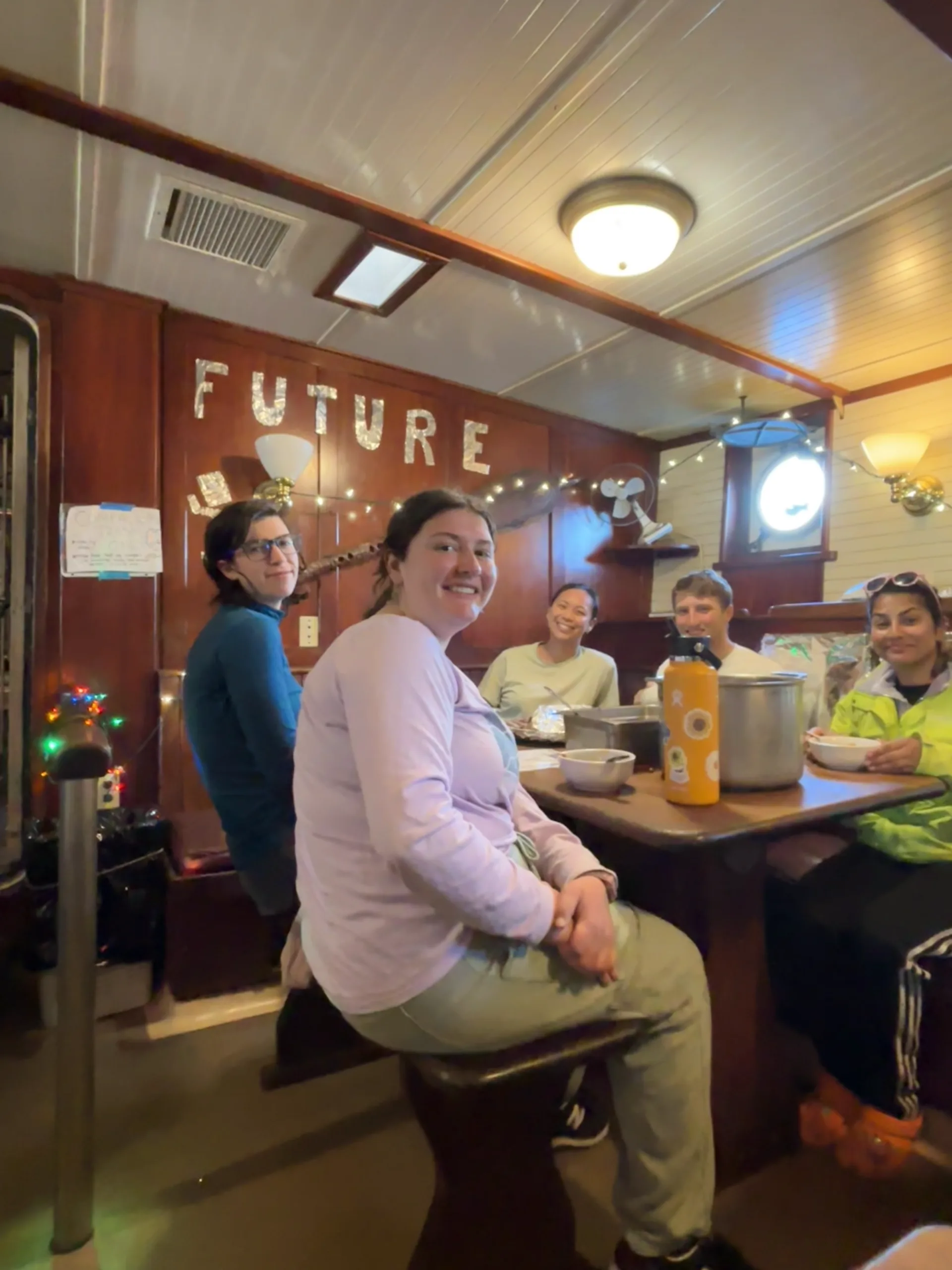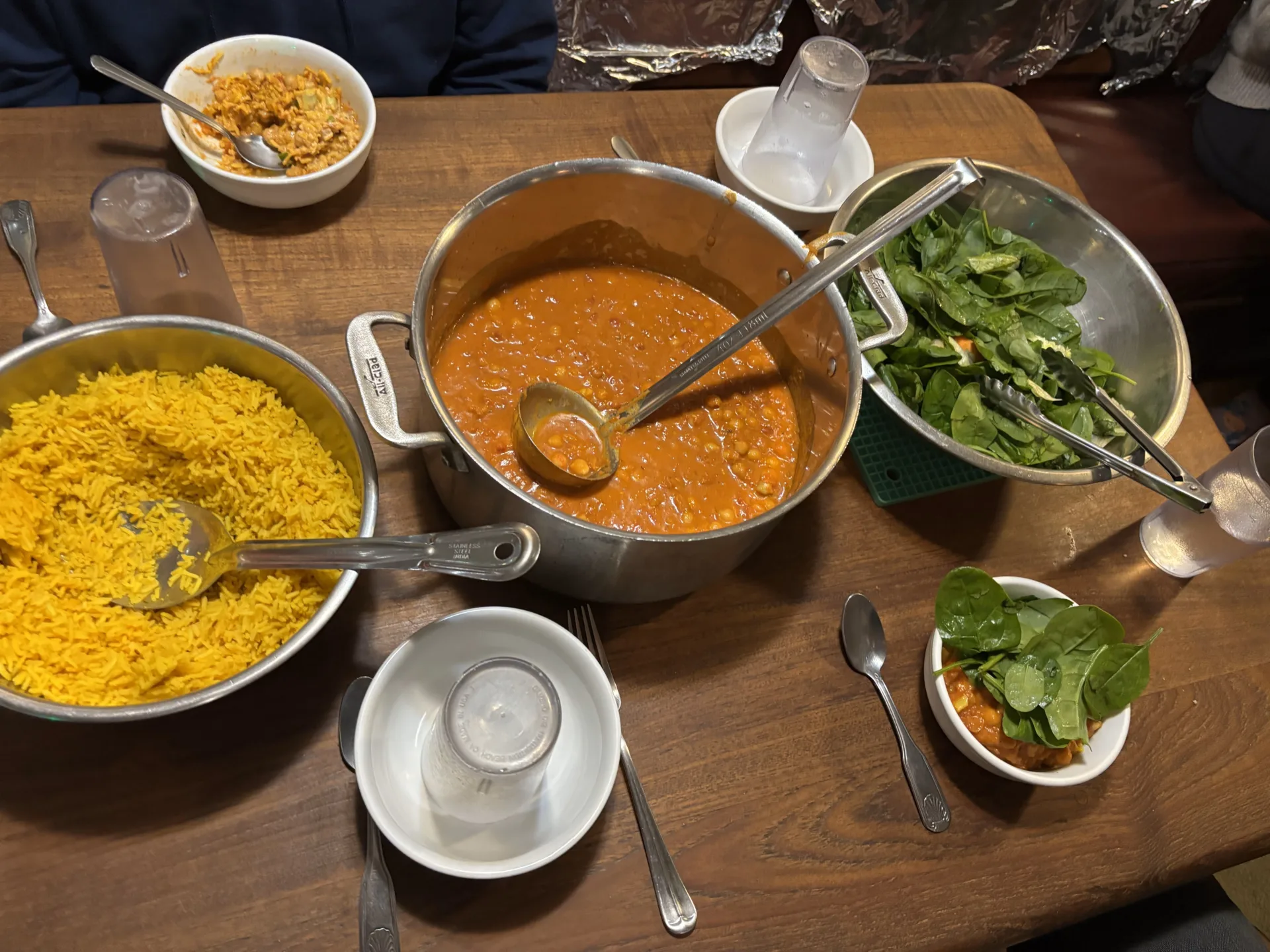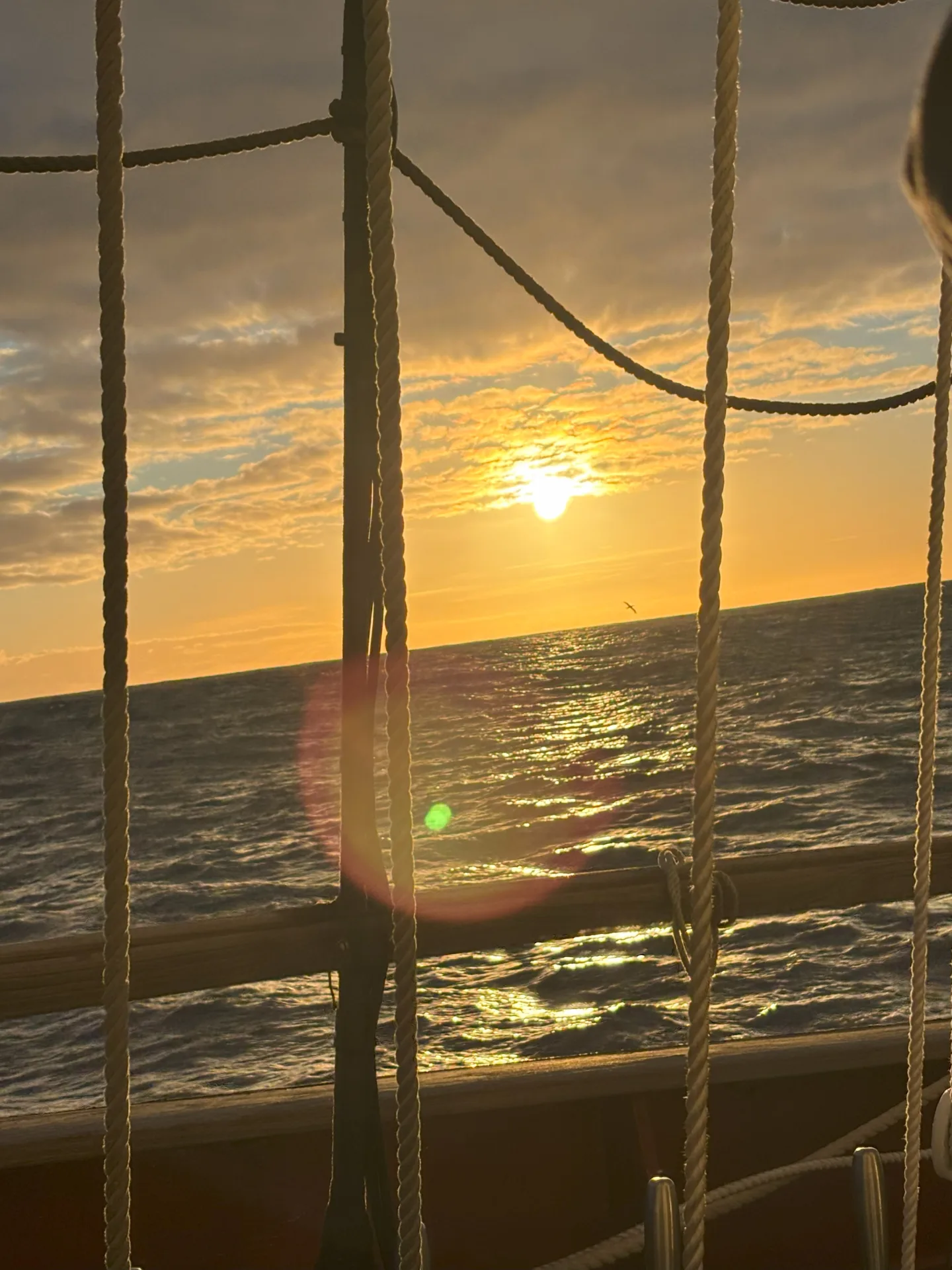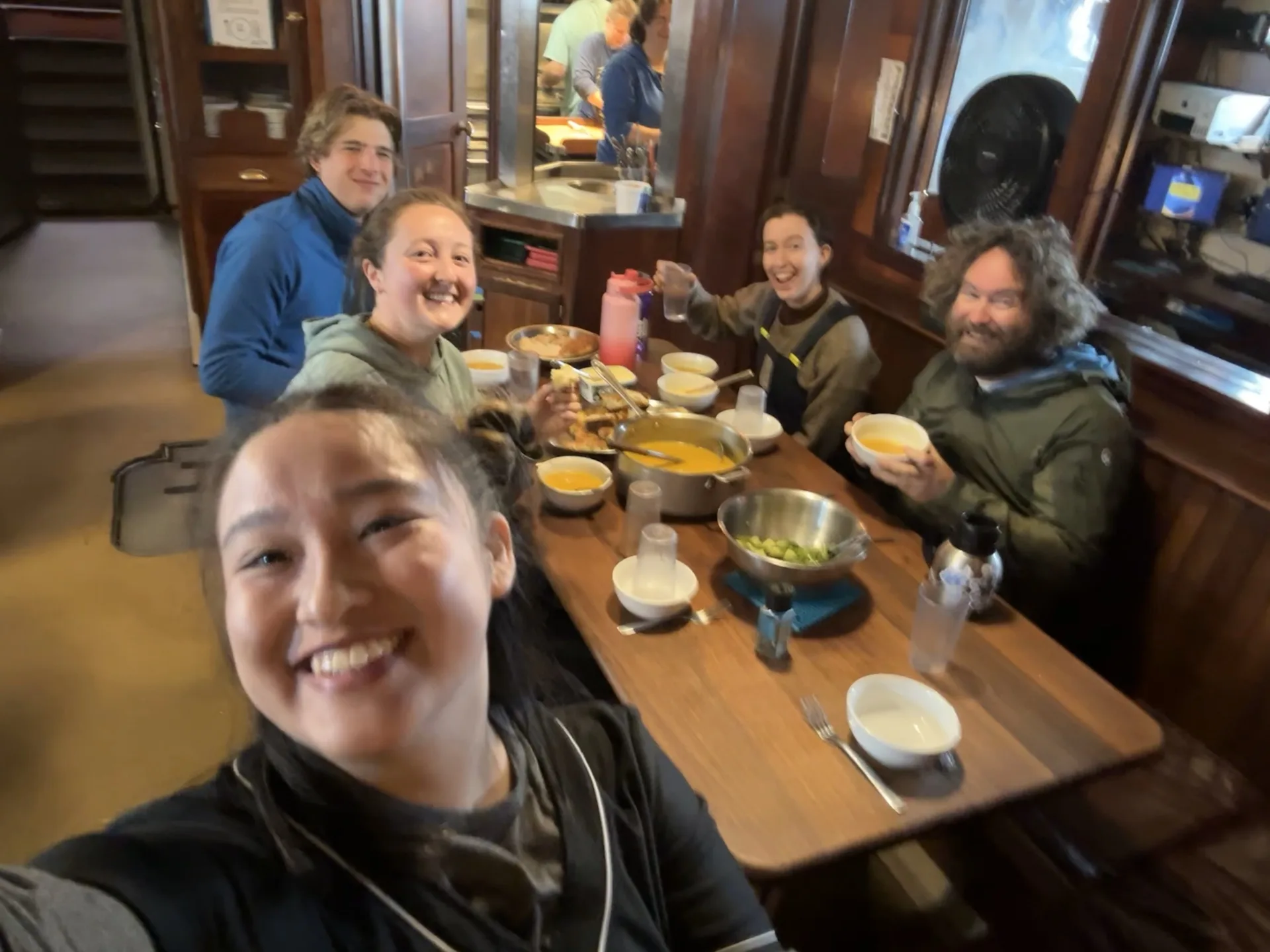Programs Blog
The Sweet Ding of the Dinner Triangle is a Sailor’s Favorite Sound

Date: April 17, 2025
Time: 1622
Location: Southern South Pacific Gyre, 37˚ 45.69’ S x 156˚ 04.72 W
Weather: Better, somehow, wind out of the ESE, force 4, waves out of the SE 6ft
WHATS UP WHATS UP WHATS UPPPPPPP! It’s Patty D once again! Now on the BOAT!
For those who still don’t know me, my name is Patricia Diaz-Bian, and I am a junior studying biochemistry at Cornell University. If you have read the previous blog posts from this trip, you would know that we are currently sailing across the South Pacific Ocean from Aotearoa New Zealand to Tahiti in the glorious hunkin’ of a vessel the SSV Robert C Seamans.
The seas have not been giving us much rest. From attempting to not squash our teeny tiny critters into bio-goop during lab, to surfing on porcelain thrones when the boat decides to sway suddenly as you attempt that relieving sit, the motion of the ocean really knows how to keep us on – or off – our toes! Despite all the daily inconveniences, the ocean swells have their charm to them. Duty on deck gives ample time to really take in the vastness of the sea. The winds roar glistening droplets of rain against your face to wash away the salt crusting on your lips and brows. Meanwhile, the waves engulf the horizon to kiss the fluffy clouds and eventually our dear Bobby Seamans (perhaps along with an unsuspecting crew member standing on lookout). Amazingly, fourteen feet swells have been a common sight on our trip so far. We’ve even encountered wave heights up to twenty feet, which is something that is apparently rarely encountered even among experienced sailors! It makes for an awesome sight to behold, but we are happy to have recently crossed the 40th latitude line to change from the “Roaring Forties” currents into the calmer “horse latitudes.”
Amidst the hectic watch schedules (a six-hour shift once every eighteen hours) that leave us constantly wondering what day it is and which way is up or down, a single team of people keep us on a steady rhythm. Our lovely stewards, Raechel and Seb (sometimes along with a student shadow, affectionately called a “stu-stew”), dutifully cook for us and call us to snacks and meals right on time on the daily. Breakfast, morning snack, lunch, afternoon snack, dinner, and “midrats” (midnight-rations) – everyone on the ship knows exactly when the food comes out. Perhaps led by their hearts or by the sweet tinkling of the meal triangle, the crew shows up to their assigned meal seating eager and on-the-dot. Mealtime is many people’s favorite time of the day. A scene often heard within minutes of finishing a meal is a wistful, “I can’t wait to eat again,” followed by a chorus of agreements.
You see, the importance of the steward’s job on the boat is often overlooked. Beyond filling bellies and spreading joy across board, they are tasked with provisioning and balancing nutrition for the crew members. The Marine Biodiversity and Conservation SEA cruise track is unique. Our path is across one of the most remote places on the planet, the South Pacific Ocean. With only the astronauts in the International Space Station being our closet human presence for a decent chunk of our trip, this also means that we have no port stops. None at all. This also means that the provisions that we left Lyttelton, New Zealand, with must last us the whole six weeks we are at sea until we reach Tahiti.
Before the invention of refrigeration or shelf-stable canning techniques, scurvy was a word that had every sailor shaking in their boots. Scurvy was a scourge on maritime history. According to the Science History Institute, death-by-scurvy was so common that shipowners and governments would just assume a 50% mortality rate via scurvy on any major oceanic voyage. Indeed, many historians even claim that scurvy was responsible for the majority of deaths out at sea. However, in the modern day this condition is noted as nothing more than an extreme vitamin C deficiency. Note the word “extreme.” While vitamin C deficiency may or may not be common depending on where you are, cases of modern-day scurvy are in fact exceedingly rare and easily prevented. On the SSV Robert C Seamans, the stewards are obviously NOT sending your children home as toothless gremlins with corkscrew hairs like a badly made Halloween clown mask from Walmart. In the words of steward Raechel, “Even just having a single spoon of ketchup should prevent scurvy from even being a consideration.” Ah how far we’ve come.
Vitamin C is most commonly associated with citrus fruits (which we have plenty of on board) but is also found in just about any fresh fruit or vegetable. Every meal is balanced like that of a home cooked meal: a carb, a protein, and a fruit or vegetable of some sort. Snack times and midrats are balanced as well, with at least one snack food per day being a healthy serving of fruits or vegetables. Unless you’re actively trying here, there’s basically no chance of getting scurvy. With the combination of modern technology and the stewards’ diligence, we should have fresh fruit and vegetables to eat even in our sixth week of sailing.
I hope you enjoyed learning a bit about boat life here, even a little as much as I’ve enjoyed living boat life. Stay tuned to upcoming blog posts to see what our fine gaggle of a crew has been up to. This is Patty D, signing out. *mic drop*
Shoutouts:
To my family- There are many moments when I look out at the sea and suddenly feel a pang of loneliness in my heart. I could be singing a Teresa Tang song and suddenly think of mom singing with me or I could be eating midrats and be reminded of dad munching on his collection of snacks while I demand to steal a few out of his hands. It’s funny how one moment I am in the galley (ship’s kitchen) and the next I am back home with grandma and grandpa, who’re trying to convince me my newest culinary escapade wasn’t a disaster as they eat with gusto and compliments. Most often of all, I think of my big brother, and I think about how he’d find this all so cool and how much I wish that he were here with me. I am always thinking of you guys, and I promise I am staying safe. You will soon be able to brag to your friends that Patricia sailed across the Pacific Ocean. I bet that this is a flex that no one else can beat.



Recent Posts from the Ships
- Ocean Classroom 2024-A collaborative high school program with Proctor Academy
- Collaborations and Long-term Commitments: SEA’s Caribbean Reef Program Sets a Course for Coastal Programs that Compliment Shipboard Experiences.
- Sea Education Association students prepare for life underway using state of the art nautical simulation from Wartsila Corporation.
- SEA Writer 2022, Magazines From the Summer SEA Quest Students
- Technology@SEA: Upgrades Allow Insight into Ocean Depths
Programs
- Gap Year
- Ocean Exploration
- High School
- Science at SEA
- SEA Expedition
- SEAScape
- Pre-College
- Proctor Ocean Classroom
- Protecting the Phoenix Islands
- SPICE
- Stanford@SEA
- Undergraduate
- Climate and Society
- Climate Change and Coastal Resilience
- Coral Reef Conservation
- Marine Biodiversity and Conservation
- MBL
- Ocean Exploration: Plastics
- Ocean Policy: Marine Protected Areas
- Oceans and Climate
- Pacific Reef Expedition
- The Global Ocean: Hawai'i
- The Global Ocean: New Zealand